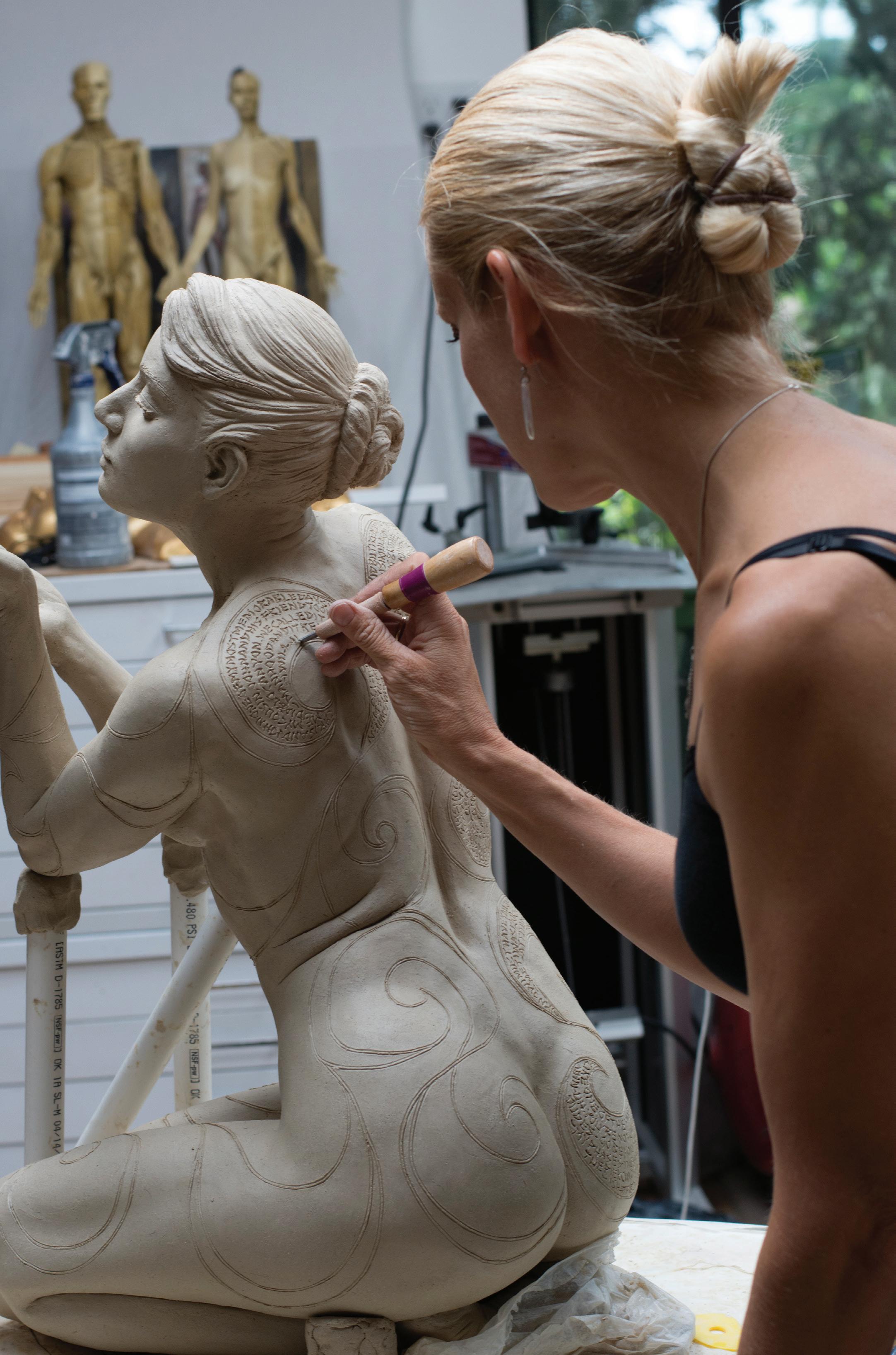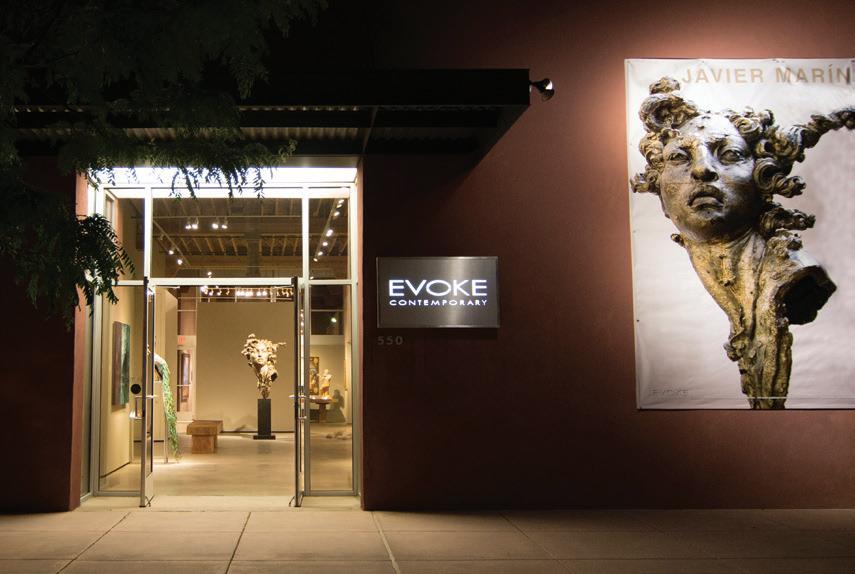
6 minute read
El Rancho de Las Golondrinas
The Story Keepers: El Ranchos de Las Golondrinas
l Rancho de las Golondrinas marks its golden anniversary. E The mudded cup of a swallows’ nest perches on a viga (ceiling rafter) inside a thick-walled adobe that is among the significant buildings visible today at El Rancho de las Golondrinas (The Ranch of the Swallows). The swallows completed their new home only recently, when a window was left open, but these enterprising songbirds have been residents of La Cienega for centuries. They’re not alone. Human residents have long made their homes in the marshlands south of Santa Fe, where history flows as fluidly as the waters of the 1739 acequia madre (mother ditch) that still feeds fields of corn, beans, squash, and chile here. As a living-history museum, El Rancho de las Golondrinas prides itself on taking history out of locked cases and placing it in visitors’ hands. This mission becomes daily reality as volunteer docents pass objects to visitors to hold, touch, and manipulate—something unheard of at other museums and preservation-oriented institutions. “There’s a very romantic view of New Mexico,” says director Daniel Goodman. “It’s important that people see the reality of this cultural landscape for themselves. I hope people gain a better understanding of history and cultures that are underrepresented on the national scale.” At the Ranch, three dozen points of interest interpreting 300 years of New Mexico’s cultural landscape sprawl over 200 acres open to guests. This year, the living-history museum marks a half-century of preservation with a lineup of events, including the Fiesta de los Ninos (September 3–4) and the Santa Fe Harvest Festival (October 1–2). Guests who’ve ducked through these low doorways once may think they know the place, but Goodman says there’s always something new to discover.
El Rancho de las Golondrinas dates to the Spanish Colonial period. Although early Spanish arrivals established a rancho in the area before the Pueblo Revolt of 1680, when indigenous peoples drove the Spanish out of New Mexico, permanent Spanish settlements didn’t take root until the 1690s. The first mention of the Ranch of the Swallows was on a 1740 will. The Rancho became an enterprise as its inhabitants harvested and milled wheat, built new homes, and raised churro sheep for wool to weave into cloth. Its location along El Camino Real de Tierra Adentro (The Royal Road of the Interior Land), a trade and migration route that stretched from Mexico City to Santa Fe, made it an official paraje (rest stop or camping ground).
Although these are the most cited and recited points on the El Rancho timeline, the landscape had been home to indigenous peoples long before the Spanish arrived. “There are thousands of years of Ancestral Puebloan history here,” Goodman says. “Although we have focused on Spanish Colonial history, you can’t tell one story without

Photos: Richard Gonzales

Photos: Richard Gonzales
the other.” He says that El Rancho is working to incorporate more and diverse voices, and has already done so with hoop dances from the Lightning Boy Foundation, demonstrations of making yucca cordage, and talks from representatives from Albuquerque’s Indian Pueblo Cultural Center.
In addition to opening its doors to more voices, El Rancho wants to welcome visitors of all ability levels. Goodman says the staff and board used the Ranch’s closure during the pandemic to update its facilities master plan. Over the next few years it will follow through on these plans by creating American Disabilities Act–compliant paths to make more of the property accessible, and add interpretive signage. When Goodman arrived, a decade ago, ropes kept visitors from interacting with most of the displays. Today, if they wish, visitors can run their fingers across the strings of calabacitas (squash), chile, garlic, and apples drying on the mantel of the Baca House. They can enjoy a moment of reflection in the pews of the Capilla y Sala de Fundadores (Chapel and Founders Hall), an 18th-century stone-walled structure that’s the oldest building on the property. They can feel the warp and weft of weavings on the loom. “We want to offer an immersive environment,” Goodman says. “We want to give people the freedom to interact, and trust that they will treat it well.”
El Rancho’s hundred-strong volunteer force is vital to helping visitors interact with the history on display. During festivals, the property buzzes as volunteers mill sorghum, forge iron tools and implements in the blacksmith shop, tan hides at a large ramada overlooking the fields, bake in los hornos (the ovens), and dye, spin, and weave fiber from El Rancho’s resident flock of churro sheep. Most days of the week, in some capacity, volunteers also carry on traditional lifeways.
At El Rancho, however, they offer third-person interpretation rather than adopt personas for reenactments, as at some East Coast living-history museums.
This living, breathing environment is a vision realized for the museum’s founder, Leonora Curtin Paloheimo (1903–1999), a preservationist who was integral in the establishment of what is now Santa Fe Indian Market. Curtin and her mother purchased the ranch property in 1932. Later, after she married, she and her Finnish husband, Yrjö Alfred (Y.A.) Paloheimo, envisioned the Ranch as the site of a living-history museum. It began welcoming visitors in 1972.
El Rancho is celebrating its golden anniversary with a slate of lectures and festivals, many of which have already taken place. The planned 50th Anniversary Fiesta Matanza will be a gala in El Rancho de las Golondrinas style. The evening will begin with Pueblo dancers, and will go on to include live Latin-fusion music from one of Santa Fe’s favorite bands, Nosotros. Steven Otero will serve food in the style of a matanza, a New Mexican harvest tradition that involves butchering and roasting a pig. While the butchering itself will take place elsewhere, guests will enjoy the resulting seasonal bounty. This event, also a fundraiser, will help secure the future of El Rancho de las Golondrinas.
Daniel Goodman’s goal for that future is simple but profound: to keep the stories alive.
—Ashley M. Biggers
19th Annual Santa Fe Fiesta de los Niños

History comes hands-on alive with games and activities for all ages, food trucks, live entertainment, and local artisans. Meet the resident goats, churro sheep, and burros!
Saturday and Sunday, September 3 and 4, 2022 10 AM–4 PM
14th Annual Santa Fe Renaissance Faire
Step back in time to the Kingdom of Golondrinas and meet knights and ladies, and fairies in their enchanted villages; eat turkey legs and other fare; dance to medieval music; and enjoy the festive atmosphere of New Mexico’s premier renaissance fair.
Saturday and Sunday, September 17 and 18, 2022 10 AM–5 PM
50th Annual Harvest Festival
Immerse yourself in the living history of El Rancho: learn how to make a traditional red-chile ristra, stomp grapes, make corn-husk crafts, visit with the resident animals, and shop handmade goods made by talented local craftspeople.
Saturday and Sunday, October 1 and 2, 2022 10 AM–4 PM
50th Anniversary Fiesta Matanza
El Rancho de las Golondrinas’s 50th-anniversary celebrations conclude with a traditional matanza, or pig-roast dinner, by chef Steve Otero, followed by dancing to the rhythms of Nosotros. Dress is ranch chic: denim and diamonds, boots and turquoise.
Saturday, October 8, 2022 6–10 PM
Fifth Annual Santa Fe Spirits of New Mexico
Hear spooky (but not too spooky) stories about the ghosts of the past, told by the light of lanterns and campfires, in a family-friendly Halloween atmosphere.
Saturday, October 22, 2022 5–9 PM
El Rancho de las Golondrinas
334 Los Pinos Road, Santa Fe Tickets and information for all events at golondrinas.org.









